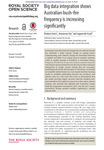Big data integration shows Australian bush-fire frequency is increasing significantly
| dc.contributor.author | Dutta, Ritaban | en_US |
| dc.contributor.author | Das, Aruneema | en_US |
| dc.contributor.author | Aryal, Jagannath | en_US |
| dc.date.accessioned | 2016-06-25T01:57:02Z | |
| dc.date.available | 2016-06-25T01:57:02Z | |
| dc.date.issued | 2016 | en_US |
| dc.identifier.other | HPU4160292 | en_US |
| dc.identifier.uri | https://lib.hpu.edu.vn/handle/123456789/21672 | |
| dc.description.abstract | Increasing Australian bush-fire frequencies over the last decade decision sciencehas indicated a major climatic change in coming future. Understanding such climatic change for Australian bush-fire is limited and there is an urgent need of scientific research, which is capable enough to contribute to Australian society. Frequency of bush-fire carries information on spatial, temporal and climatic aspects of bush-fire events and provides contextual information to model various climate data for accurately predicting future bush-fire hot spots. In this study, we develop an ensemble method based on a two-layered machine learning model to establish relationship between fire incidence and climatic data. | en_US |
| dc.format.extent | 11 p. | en_US |
| dc.format.mimetype | application/pdf | |
| dc.language.iso | en | en_US |
| dc.publisher | The Royal Society | en_US |
| dc.subject | Earth science | en_US |
| dc.subject | Artificial intelligence | en_US |
| dc.subject | Atmospheric | en_US |
| dc.subject | Science | en_US |
| dc.subject | Environmental science | en_US |
| dc.subject | Bush-fire frequency | en_US |
| dc.subject | Ensemblemachine | en_US |
| dc.subject | Learning | en_US |
| dc.subject | Big data | en_US |
| dc.subject | Climatic shift | en_US |
| dc.title | Big data integration shows Australian bush-fire frequency is increasing significantly | en_US |
| dc.type | Book | en_US |
| dc.size | 1.34MB | en_US |
| dc.department | Education | en_US |
Files in this item
This item appears in the following Collection(s)
-
Education [806]

